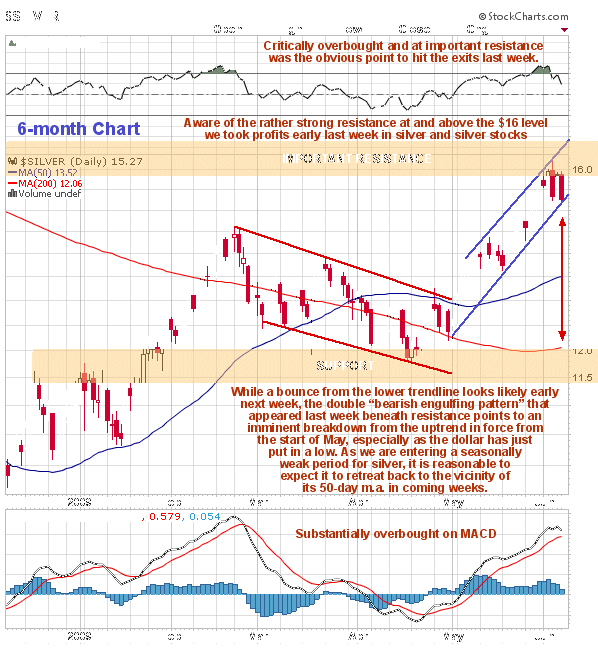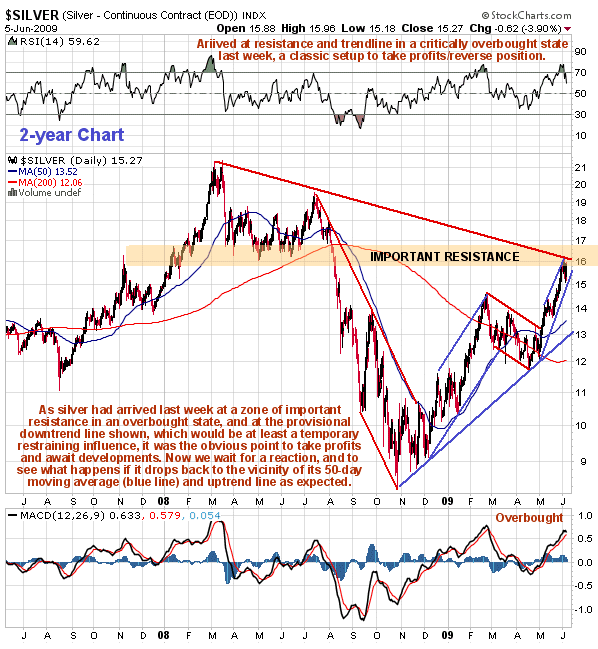Silver Ugly Double Bearish Engulfing Chart Pattern
Commodities / Gold & Silver 2009 Jun 08, 2009 - 04:29 AM GMTBy: Clive_Maund
 Silver has behaved pretty much as forecast in the last update posted late in April, entering into a fairly vigorous uptrend that has taken it up to our minimum target at the strong resistance at and above $16. It even paused and reacted at the $14.30 area as predicted. Last week, however, it showed signs of serious technical deterioration, so that even though it is still just within the uptrend, it is thought likely that it will soon break down into a reactive phase, and as silver has a habit of going down one helluva lot faster than it goes up, experienced traders will know what that means.
Silver has behaved pretty much as forecast in the last update posted late in April, entering into a fairly vigorous uptrend that has taken it up to our minimum target at the strong resistance at and above $16. It even paused and reacted at the $14.30 area as predicted. Last week, however, it showed signs of serious technical deterioration, so that even though it is still just within the uptrend, it is thought likely that it will soon break down into a reactive phase, and as silver has a habit of going down one helluva lot faster than it goes up, experienced traders will know what that means.

On the 6-month chart you can see why we started to get out of our silver and silver stock positions early last week and continued unloading them through the middle of the week. For silver arrived at the zone of important resistance shown in a critically overbought condition, as shown by the RSI indicator at the top of the chart. With the week's trading over we can see an ugly double "bearish engulfing pattern" on the chart, which is also evident on the gold chart. This pattern points to an imminent breakdown and sharp retreat, although with the RSI now fast neutralising, we might see a brief rally first very early this coming week. The still substantially overbought MACD indicator at the bottom of the chart and the rather large gap with the moving averages show there is plenty for a room for a significant reaction here. A big reason for this expected reaction will be a continuation of the dollar recovery that began last week, which we considered in the Gold Market update, to which you are referred for details.

The 2-year chart for silver is interesting as it shows the origin of the quite strong resistance at and above $16, which we can trace back to the large quantity of trading that occurred at and above the $16 level between about January and July of last year. Earlier buyers "hung up" in this top pattern are taking the opportunity to "get out even" once the price gets up near to where they bought, hence the resistance. The 2-year chart also gives us some further clues as to where the expected reaction is likely to terminate.
The vicinity of the rising 50-day moving average is frequently a place where reactions end, and here we can see that not far beneath this average we have a longer-term uptrend line of some significance which started from the lows of last Fall. So it looks likely that the reaction from the steeper uptrend shown on the 6-month chart will end in the vicinity of the 50-day moving average, and at or above the uptrend line. While a breach of this uptrend line would certainly not be a positive development, a break below the support at the April lows in the $11.80 area would be regarded as a more bearish development. However, we will be looking for evidence of basing action at or above the uptrend line dating back to last October.
By Clive Maund
CliveMaund.com
For billing & subscription questions: subscriptions@clivemaund.com
© 2009 Clive Maund - The above represents the opinion and analysis of Mr. Maund, based on data available to him, at the time of writing. Mr. Maunds opinions are his own, and are not a recommendation or an offer to buy or sell securities. No responsibility can be accepted for losses that may result as a consequence of trading on the basis of this analysis.
Mr. Maund is an independent analyst who receives no compensation of any kind from any groups, individuals or corporations mentioned in his reports. As trading and investing in any financial markets may involve serious risk of loss, Mr. Maund recommends that you consult with a qualified investment advisor, one licensed by appropriate regulatory agencies in your legal jurisdiction and do your own due diligence and research when making any kind of a transaction with financial ramifications.
Clive Maund Archive |
© 2005-2022 http://www.MarketOracle.co.uk - The Market Oracle is a FREE Daily Financial Markets Analysis & Forecasting online publication.



